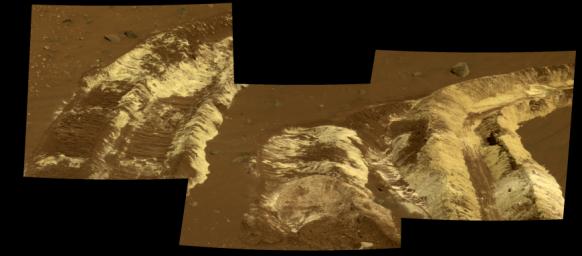While driving eastward toward the northwestern flank of "McCool Hill," the wheels of NASA's Mars Exploration Rover Spirit churned up the largest amount of bright soil discovered so far in the mission. This image from Spirit's panoramic camera (Pancam), taken on the rover's 788th Martian day, or sol, of exploration (March 22, 2006), shows the strikingly bright tone and large extent of the materials uncovered.
Several days earlier, Spirit's wheels unearthed a small patch of light-toned material informally named "Tyrone." In images from Spirit's panoramic camera, "Tyrone" strongly resembled both "Arad" and "Paso Robles," two patches of light-toned soils discovered earlier in the mission. Spirit found "Paso Robles" in 2005 while climbing "Cumberland Ridge" on the western slope of "Husband Hill." In early January 2006, the rover discovered "Arad" on the basin floor just south of "Husband Hill." Spirit's instruments confirmed that those soils had a salty chemistry dominated by iron-bearing sulfates. Spirit's Pancam and miniature thermal emission spectrometer examined this most recent discovery, and researchers will compare its properties with the properties of those other deposits.
These discoveries indicate that salty, light-toned soil deposits might be widely distributed on the flanks and valley floors of the "Columbia Hills" region in Gusev Crater on Mars. The salts, which are easily mobilized and concentrated in liquid solution, may record the past presence of water. So far, these enigmatic materials have generated more questions than answers, however, and as Spirit continues to drive across this region in search of a safe winter haven, the team continues to formulate and test hypotheses to explain the rover's most fascinating recent discovery.
This view is an approximately true-color rendering that combines separate images taken through the Pancam's 753-nanometer, 535-nanometer, and 432-nanometer filters.

 Planetary Data System
Planetary Data System












